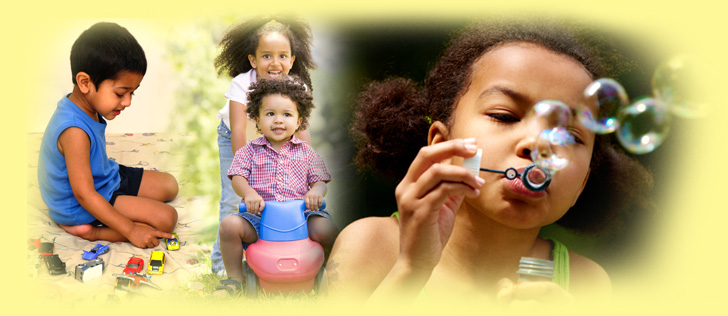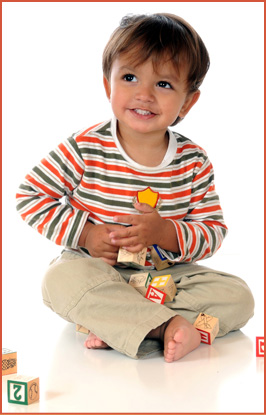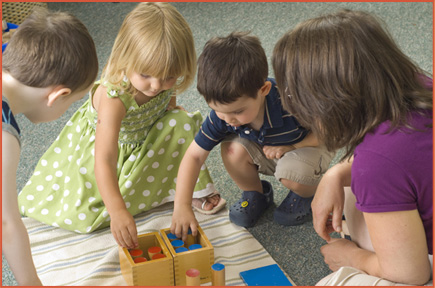| |
Safety Practices to Prevent: |
| Falls/ Cuts |
- Infant or child is not left unattended on above ground surfaces (e.g., change tables, climbers)
- Safety gates are installed and used at stairs inside home or on decks
- Infant walker/baby exerciser or similar equipment on wheels is not used
- Baby jumpers have been properly secured to a door frame and are used only under supervision
- Child is always supervised near or on balcony, staircase, or playground
- Protective rail is used on beds for children
- The top level of a bunk bed is only used with children 6 years of age or older
- Child plays on playgrounds with impact-absorbing materials to soften falls
- Child wears a safety helmet during bike riding, rollerblading, skateboarding or similar activities
- Safety devices are installed on windows, patio and balcony doors
- Sharp instruments (e.g., scissors, knives) are not within child's reach
|
| Motor Vehicle or Traffic Accidents |
- Car seats and booster seats are installed properly and used properly according to age, height and weight of the child
- Child plays in safe areas away from parked cars or road
- Child is taught how to "stop, look and listen"
|
| Drowning |
- Swimming pools or hot tubs are fenced in and can only be accessed through a locked gate
- A supervising adult is within arms length of the child while near any water that is deeper than 5 cm (2 inches) (e.g., pools, bathtubs, ponds)
- Baby bath seats or rings are not used
|
| Burning/Scalding |
- Home water temperature is set to 49 degree Celsius or less
- Bath water is tested before putting child in bathtub (should be 49 degrees Celsius or less)
- Cold water faucets are turned on before hot water faucets when washing hands
- Hot liquids and foods are kept away from a child especially while carrying the child
- Pot handles are turned towards centre of stove; hot soup is one of the leading causes of childhood scalding injury in the United States (WHO, 2008)
- Smoke and carbon dioxide alarms are used throughout the house or apartment
- Fire extinguisher is present in the kitchen and caregivers know how to use it
- Barrier is used around fireplace or wood burning stove
- Matches or lighters and other flammable substances are not within a child's reach
|
| Sunburns |
- Protective clothing such as wide brimmed hats are used when children are outdoors
- Playing in the sun is avoided during peak sun hours (10am - 2pm)
- Sunscreen is applied to children over 6 months 30 minutes before such exposure and reapplied every 2 - 3 hours
- Spaces where children play are designed with structures providing shade
|
Suffocation/ Choking/
Strangulation |
- Small objects such as food (e.g., hard candy, nuts, popcorn, grapes, hotdog pieces), beads, coins, small parts of toys, are kept away from infants or toddlers under 3 years of age
- Cribs are placed away from windows, blinds, curtain cords, straps, lamps, electrical plugs, and extension cords
- Child is not wearing pacifier, jewelry, cord, string or skipping rope around neck
- Child does not play on playground equipment wearing scarves or clothing with cords or drawstrings
|
| Poisoning/ Electrocution |
- Child-resistant caps/packaging are used on medications and household poisons and kept out of reach
- Cupboards containing poisonous items such as household cleaning products, medications, pesticides are locked with childproof locks
- Toxic or poisonous plants are not within child's reach or not kept in or around the home until the child understands the danger
- Electrical outlets are covered with plastic safety covers
|
Sudden Infant Death Syndrome (SIDS)/ Sudden Unexpected Death in Infancy (SUDI)
(applies to infants from birth to 12 months) |
- Infant is placed on his back for night time sleep and all naps
- Infant is placed in a crib with only a tightly fitted sheet and light blanket or sleep sac
- Infant is not placed to sleep on waterbeds, futons, couches, loveseats, chairs, car seats, makeshift beds or adult beds
- Infant sleeps in the parents' room for the first 6 months
- Infant is not overheated
- Bumper pads, duvets, pillows, heavy blankets and soft toys are not used in the crib
- Infant is put to sleep in a smoke free environment
- Infant does not share a sleep surface with others
|
| Crib and Equipment Safety |
- Cribs made before September 1986 are not used because they do not meet current Canadian safety regulations
- The crib is not modified
- Children younger than two years of age sleep in a crib
- Equipment is used according to manufacturer's instructions
- Equipment is used according to age limitations
- Equipment is checked for recalls
|
| Environmental Toxins and Pollutants |
- Home is free from second-hand and third-hand smoke (toxic chemicals released by smoking that are trapped in hair, skin, fabric, carpet, furniture, and toys)
- Child uses good quality toys without lead
- Lead-free paint is used in the home
- Home is kept clean (dust in older homes may contain lead) and free from allergens and moulds
- Mercury thermometer is not used
- Breastmilk, formula or food is not heated in plastic bottles or containers containing Bisphenol A
- Cold tap water is used for drinking water or to reconstitute drinks including formula (hot tap water contains more lead)
- In homes older than 1990, water is run for 2 minutes every morning before using it to make formula, other drinks or baby food
- Vinyl toys are not used for young children (chemicals can be absorbed through chewing and sucking)
- Children's art materials (e.g., markers, paints) are made of non-toxic materials
- Outdoor footwear is removed inside (e.g., metals, pesticides, and animal droppings can be tracked into the home on outdoor footwear)
- Children's playground equipment or picnic tables are made from cedar, redwood or metal, not pressure treated wood (may contain arsenic)
- Children are kept away from paints, glues, new carpets and similar things that may give off chemical gases
- Pesticides or harsh cleaning chemicals are not used near children
- Children are kept indoors on days when the air quality is poor
Additional information can also be obtained at:
http://www.toronto.ca/health/hphe/children.htm http://beststart.org/resources/env_action/pdf/AppB_auditform.pdf |



 Even the safest space does not reduce the need for adequate adult supervision. Adults must always remain vigilant and anticipate the child's needs, actions and level of development. Active supervision means that the adult stays close, especially when the child is exploring new equipment, play structures or trying new skills. The adult should scan the environment for any potential hazards and remove them, if possible, and make sure the children are not creating risks to their own safety or the safety of other children.
Even the safest space does not reduce the need for adequate adult supervision. Adults must always remain vigilant and anticipate the child's needs, actions and level of development. Active supervision means that the adult stays close, especially when the child is exploring new equipment, play structures or trying new skills. The adult should scan the environment for any potential hazards and remove them, if possible, and make sure the children are not creating risks to their own safety or the safety of other children.  Communicating with the family
Communicating with the family